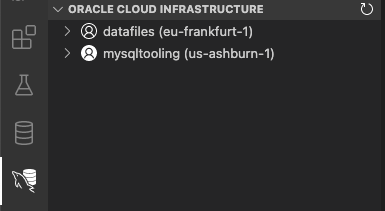The ORACLE CLOUD INFRASTRUCTURE view lists all of the
configuration profiles defined in the
~/.oci/config file on your system.
MySQL Shell for VS Code identifies and highlights your default
profile, if indicated, by checking the definition in
~/.oci/oci_cli_rc.
For example, the following figure shows that the
mysqltooling (us-ashburn-1) profile is
indicated as the default. A refresh action in the toolbar enables
to update your profile information, including all of the
compartment nodes contained under each profile.
To open profiles in ORACLE CLOUD INFRASTRUCTURE view, you must first create a connection to your existing account in an Oracle Cloud Infrastructure (OCI) tenancy.
Each profile contains a hierarchical listing for:
Your default compartment (identified by a highlighted folder icon).
An OCI compartment tree for each configuration profile's tenancy.
All subordinate compartments, MySQL DB Systems, Compute Instances, Bastions, and Load Balancers of the given compartment.
